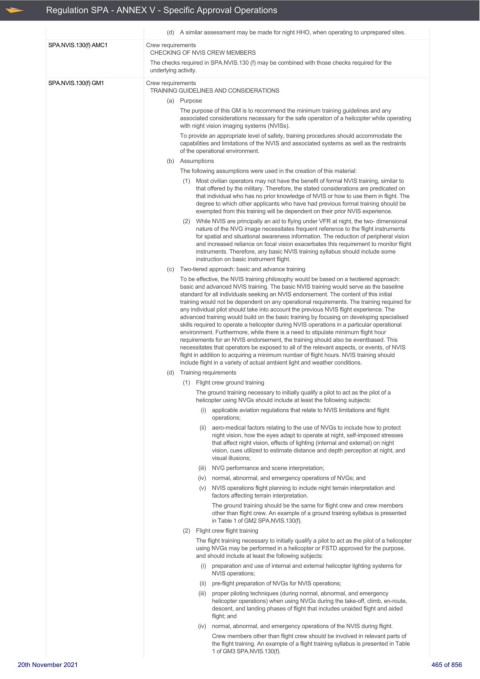Page 465 - UK Air Operations Regulations 201121
P. 465
~
~ Regulation SPA - ANNEX V - Specific Approval Operations Centrik
(d) A similar assessment may be made for night HHO, when operating to unprepared sites.
SPA.NVIS.130(f) AMC1 Crew requirements
CHECKING OF NVIS CREW MEMBERS
The checks required in SPA.NVIS.130 (f) may be combined with those checks required for the
underlying activity.
SPA.NVIS.130(f) GM1 Crew requirements
TRAINING GUIDELINES AND CONSIDERATIONS
(a) Purpose
The purpose of this GM is to recommend the minimum training guidelines and any
associated considerations necessary for the safe operation of a helicopter while operating
with night vision imaging systems (NVISs).
To provide an appropriate level of safety, training procedures should accommodate the
capabilities and limitations of the NVIS and associated systems as well as the restraints
of the operational environment.
(b) Assumptions
The following assumptions were used in the creation of this material:
(1) Most civilian operators may not have the benefit of formal NVIS training, similar to
that offered by the military. Therefore, the stated considerations are predicated on
that individual who has no prior knowledge of NVIS or how to use them in flight. The
degree to which other applicants who have had previous formal training should be
exempted from this training will be dependent on their prior NVIS experience.
(2) While NVIS are principally an aid to flying under VFR at night, the two- dimensional
nature of the NVG image necessitates frequent reference to the flight instruments
for spatial and situational awareness information. The reduction of peripheral vision
and increased reliance on focal vision exacerbates this requirement to monitor flight
instruments. Therefore, any basic NVIS training syllabus should include some
instruction on basic instrument flight.
(c) Two-tiered approach: basic and advance training
To be effective, the NVIS training philosophy would be based on a twotiered approach:
basic and advanced NVIS training. The basic NVIS training would serve as the baseline
standard for all individuals seeking an NVIS endorsement. The content of this initial
training would not be dependent on any operational requirements. The training required for
any individual pilot should take into account the previous NVIS flight experience. The
advanced training would build on the basic training by focusing on developing specialised
skills required to operate a helicopter during NVIS operations in a particular operational
environment. Furthermore, while there is a need to stipulate minimum flight hour
requirements for an NVIS endorsement, the training should also be eventbased. This
necessitates that operators be exposed to all of the relevant aspects, or events, of NVIS
flight in addition to acquiring a minimum number of flight hours. NVIS training should
include flight in a variety of actual ambient light and weather conditions.
(d) Training requirements
(1) Flight crew ground training
The ground training necessary to initially qualify a pilot to act as the pilot of a
helicopter using NVGs should include at least the following subjects:
(i) applicable aviation regulations that relate to NVIS limitations and flight
operations;
(ii) aero-medical factors relating to the use of NVGs to include how to protect
night vision, how the eyes adapt to operate at night, self-imposed stresses
that affect night vision, effects of lighting (internal and external) on night
vision, cues utilized to estimate distance and depth perception at night, and
visual illusions;
(iii) NVG performance and scene interpretation;
(iv) normal, abnormal, and emergency operations of NVGs; and
(v) NVIS operations flight planning to include night terrain interpretation and
factors affecting terrain interpretation.
The ground training should be the same for flight crew and crew members
other than flight crew. An example of a ground training syllabus is presented
in Table 1 of GM2 SPA.NVIS.130(f).
(2) Flight crew flight training
The flight training necessary to initially qualify a pilot to act as the pilot of a helicopter
using NVGs may be performed in a helicopter or FSTD approved for the purpose,
and should include at least the following subjects:
(i) preparation and use of internal and external helicopter lighting systems for
NVIS operations;
(ii) pre-flight preparation of NVGs for NVIS operations;
(iii) proper piloting techniques (during normal, abnormal, and emergency
helicopter operations) when using NVGs during the take-off, climb, en-route,
descent, and landing phases of flight that includes unaided flight and aided
flight; and
(iv) normal, abnormal, and emergency operations of the NVIS during flight.
Crew members other than flight crew should be involved in relevant parts of
the flight training. An example of a flight training syllabus is presented in Table
1 of GM3 SPA.NVIS.130(f).
20th November 2021 465 of 856

